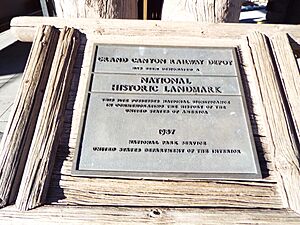Grand Canyon Depot facts for kids
|
Grand Canyon Depot
|
|
|
U.S. National Historic Landmark District
Contributing Property |
|

Grand Canyon Depot
|
|
| Location | South Rim, Grand Canyon, Arizona |
|---|---|
| Built | 1909 |
| Architect | Francis W. Wilson |
| Part of | Grand Canyon Village Historic District (ID75000343) |
| NRHP reference No. | 74000337 |
Quick facts for kids Significant dates |
|
| Added to NRHP | September 06, 1974 |
| Designated NHL | May 28, 1987 |
| Designated NHLDCP | February 18, 1987 |
The Grand Canyon Depot, also known as the Grand Canyon Railroad Station, is a special building located at the South Rim of the Grand Canyon in Grand Canyon National Park, Arizona. It was built between 1909 and 1910 for the Atchison, Topeka and Santa Fe Railway. This depot is unique because it's one of only three train stations in the United States made mostly from logs. It stands very close to the edge of the canyon, right across from the famous El Tovar Hotel. Because it's so important, the Grand Canyon Depot is recognized as a National Historic Landmark.
Contents
A Special Train Station
At the start of the 1900s, the Santa Fe Railway company wanted to turn the South Rim of the Grand Canyon into a popular travel spot. This was even before the area became a national park. The railway needed a train station that would fit in with the wild, natural beauty of the canyon.
The company decided to build a rustic, log-style station. This style later became known as the National Park Service Rustic style. It was often used for buildings in national parks, like those in the Grand Canyon Village Historic District. The railway's main goal was to bring more passengers to the Grand Canyon, making their train lines busier. This led to the Grand Canyon branch line becoming the only railway line that went directly into a national park.
Building the Depot
The first railway line to the Grand Canyon was started in 1897 by the Santa Fe and Grand Canyon Railroad. They wanted to reach a copper mine. But this plan didn't work out, and the tracks stopped about eight miles short of the canyon.
Then, in 1901, a company called the Grand Canyon Railway (which was part of the Santa Fe company) bought the project. They finished the tracks all the way to the South Rim. They also built a small train yard and a simple wooden building for passengers.
In 1905, the beautiful El Tovar Hotel was finished. It became clear that the small train station wasn't grand enough to match the hotel and the amazing Grand Canyon experience.
The new train station was built a bit to the east, away from an older hotel called the Bright Angel Hotel. It was placed right across from the El Tovar Hotel. Francis W. Wilson, an architect for the Santa Fe Railway, was chosen to design the new station. He had just finished working on the Bright Angel Hotel.
Wilson designed the Grand Canyon Depot to be the only log building of his career. He used materials that looked similar to the El Tovar Hotel, but he paid even more attention to how it was built and the small details.
The Grand Canyon Depot stopped being a regular passenger station in 1968. In 1982, the National Park Service bought the building. Then, in 1989, the Grand Canyon Railway started up again as a tourist train. It now brings visitors from Williams, Arizona to the South Rim, and the depot is used by passengers once more!
What Does It Look Like?
The Grand Canyon Depot is a two-and-a-half-story building made mostly of wood. It's about 3,000 square feet in size. The main part of the building is made from logs, and it has a wide, gently sloped roof.
The second story is built with wood frames and covered with flat wooden planks. This part is in the middle of the building and has its own roof that crosses the main roof. The second story hangs out over the first floor, supported by strong log posts.
On the west side, there's a large porch with two openings, also supported by log posts. A small, one-story section sticks out a little from the middle of the building.
Inside, the depot has four main rooms. From west to east, you'll find a ticket office and waiting room, an agent's office, a room for storing packages, and a baggage room. There are also restrooms between these rooms and the train platform. The inside walls are plastered, and the lower parts of the walls have wood paneling made from log slabs.
Upstairs, there's a small apartment where the station agent used to live. It has a living room, a kitchen, a bathroom, and two bedrooms. Many of the original metal parts, like door handles, are still there and are stamped with "GC" for Grand Canyon.
Why Is It Important?
The Grand Canyon Depot was named a National Historic Landmark on May 28, 1987. This means it's a very important place in American history. It is also part of the larger Grand Canyon Village National Historic Landmark District.
Images for kids









